Each group of Indians has members with certain leadership roles. There is always a Big Chief, and sometimes a Second Chief and even a Third Chief. The Chief is protected by other tribal members and is the one to stand up to challenge from another tribe's Big Chief, when two tribes meet. Even today, when a tribe parades, the Big Chief is often surrounded by other tribe members as well as non-costumed friends and relations. There is also a Flag Boy, who carries a banner with the name of the tribe on it, and a Spy Boy, who ventures out ahead of the Big Chief and his entourage, on the lookout for other tribes. There may also be a Wild Man, a member who protects the Chief and was formerly armed, but today just behaves somewhat erratically and serves to warn or frighten children to be obedient to their elders. Within a Tribe (or more properly, a Gang) the position of Big Chief may be passed from father to son, but only if the son is judged worthy of the honor.
In the early part of the 20th century, and certainly until the immediate post WW2 period, the Indians were a pretty rough bunch. When two Gangs met, they would fight, sometimes with weapons, until one group gave up the field and retreated back to their own neighborhood. The Gangs were not well regarded by the mainstream of the African American community, and were regarded as criminals by the police department. If police happened upon a group of parading Indians, the officers usually beat and sometimes arrested the Indians. On Mardi Gras day, many Indians returned home bloodied with ruined costumes from fights with other Indians and / or the police. Some of the leaders of the Indian Tribes, however, began to work change the traditions, and move the groups from a violent past (Tootie Montana - below) to a non-violent future, and to bring the groups musical traditions into the public space (Bo Dollis, Monk Boudreaux). Tootie Montana was also a leader in making more elaborate and beautiful costumes, movine the competition away from physical violenct toward the design and execution of more lovely costumes. The Big Chiefs began to compete to see who was "the prettiest".
The violent traditions of the Indians changed gradually under the leadership of Allison "Tootie" Montana (1922 - 2005). Tootie was the Big Chief of the Yellow Pocohontas Tribe just prior to WW2, and after the war, he started the Monogram Hunters with some friends. Tootie became known for his elaborate costumes which featured geometric beadwork, and in time he rose to become the "Chief of Chiefs", an honorary title for the leader of a group of tribes. Tootie was unhappy with the traditional violence associated with the Indian traditions and worked all his life to change it. He emphasized the beauty of the costume and gradually other tribes came around to his viewpoint that the way for the tribes to compete was through the beauty of their costumes, as well as their music, and the poetic "trash talk" exchanged between Big Chiefs when they met during parades. By the early 200o, the Indians had become non-violent in their confrontations, although they were still subject to abuse, sometimes savage, by members of the police department.
In 2005, after a bloody assault upon large numbers of Indians by the police on St Joseph's Day Tootie and other Indian leaders were addressing the City Council with an passionate speech about the non-violent nature of the modern Indian tradition, and the need for the council to stop the police abuse of the Indians. During the meeting, Tootie had a fatal heart attack.
Today, thanks largely to Tootie and his colleagues, the Mardi Gras Indian tradition is very much still with us. Through cooperative agreements with the police department, Indians parade on scheduled routes at scheduled times, largely free from police harassment, and the parades are open to the public, and all are welcomed. The boast of every Big Chief is that he is "The Best and the Prettiest". Today, the costumes are ever more elaborate and incorporate many different beads. I often think of Eddie Casanave when I see the beadwork these days. Also, there are female Tribes, and formerly all male tribes often have a "Queen" consort for the Big Chief, and children who also dress in costume and walk with the Tribe. Truly, the Indian parades have become a family event for participants and spectators. And as the costumes have gotten more and more elaborate and costly (sometimes tens of thousands of dollars) individual Indians have begun to re-use parts of the costumes or to donate or sell them to organizations which will preserve them. When you are in New Orleans, be sure to visit the Back Street Cultural Museum in Treme to learn more about the Indians and see many costumes there.
Music of the Mardi Gras Indians
In the early days of the Indian parades, they were accompanied by drums and tambourines. Spectators,
non-costumed members of the group, family members, and friends also beat out a typical New Orleans
rhythm on drums, cowbells, coke bottles, cans, and buckets to go with the songs and chants sung by
and about
the Indian Tribe. The songs are traditional and many are sung in the language of the Indians, a mix of
African languages, some Native American languages, and some created vocabulary. No written translations
exist to my knowledge, but some of the songs have made it into popular music in part. Think of the
lyrics of "Iko, Iko".
"Hey now! Hey now! Iko iko wan dey
Jock-a-mo fi no wan an dey
Jock-a-mo fi na ney"
This song probably is derived from a discription of the encounter of two Indian Tribes, but I cannot
otherwise tell you what it means. Malcolm John "Mac" Rebbenack, aka Dr. John, also incorporated much
of the Indian musical tradition into his music and shared it with the world. It is the foundation of New
Orleans "funk".
Theodore "Bo" Dollis was the fourth Big Chief of the Wild Magnolias Tribe, and is recognized for first recording the music of the Indians around 1970. The group subsequently performed in costume during the year at times other than Mardi Gras or St. Joseph's Day and made two recordings which were modestly successful nationally. The singers were accompanied mostly by percussion instruments (snare drum, tom-tom, cymbals, cowbell, cans, bottles, etc.) with the addition of piano and guitar in later work. After some initial success, the group declined in popularity, except locally, until the late 1980s, when Alison Minor helped revive them, and boosted their career. They toured nationally and internationally with Dr. John and other New Orleans musicians, and continue to perform today.
Monk Boudreaux was an early member of the Wild Magnolias, joining the group in 1970 and performing with them until he left in 2001 to pursue a solo career. Other Indian musical groups perform often these days, especially at the New Orleans Jazz and Heritage Festival and at some musical clubs in New Orleans.
The Neville Brothers are perhaps the best known musicians to come out of the Mardi Gras Indian musical tradition. One of their earliest recordings was with the Wild Tchopitoulas Tribe, under the leadership of their uncle, George Landry, aka Chief Jolly.
Organization of the tribes
The Indian Tribes are almost always based in a neighborhood and made up of residents of that neighborhood, although that is not exclusively true. The tribes fall into two categories Uptown and Downtown tribes, with Canal Street being the rough boundary between the two. The tribes in each area are loosely joined in a confederation, so there is a chief of the uptown tribes and a chief of the downtown tribes, and sometimes a "Chief of the Chiefs". Each area also has differing traditions in costume design, music, and languages. Uptown tribes, for example, create elaborate pictorial beadwork, with representation of Native American themes, while Downtown tribes favor more geometric patterns and sculptural designs for their costumes. Before the great pacification led by Tootie Montana, Canal Street was a dividing line, and uptown Indians ventured below it at their peril and vice versa. There were several locations known as battlefields because of the violent clashes there. Today, there are two great convocations of Indians coordinated by the two major groups.
The first is a gathering of Uptown Tribes on the Sunday nearest to St. Joseph's Day, called "Super Sunday" and is held at the A.L.Davis Park, at the Intersection of Washington Avenue and Lasalle Street. The park is across from the former "Magnolia Project" aka C.J. Peete Projects, now re-incarnated as "Harmony Oaks", a mixed use residential housing area. The location has a long history with the African American community, and "Uptown Super Sunday" draws large crowds to see the Indians, Babydolls, musical acts in the Park, and the street food there. The Indians parade from to Lasalle street from different directions along the streets leading to the Park before combining into a parade which moves through the area, in the central city neighborhoods (above Canal Street).The second event is "Downtown Super Sunday" which happens on Bayou St. John in the part of town known as "Mid City". The Indians gather on the open ground along the levee which borders the Bayou between Orleans Avenue and what is now the Lafitte Greenway. This is event usually several weeks after the uptown Super Sunday, and is different, as the Indians all assemble before the parade, and spend time socializing, comparing costumes, and getting dressed. There they are avaliable for photographs and conversation before suiting up to parade along Orleans Avenue to Broad Street and further downtown into the Seventh Ward.
Both events draw tribes from both uptown and downtown and the West Bank, so both are excellent opportunities to see the differences in the artistic design of individual tribes.
There is also a "Westbank Super Sunday", hosted by tribes from Algiers on the other side of the Mississippi River from the main parts of New Orleans. These tribes also participate in Super Sunday events on the "east bank".
There are many Indian Tribes/Gangs active in New Orleans today, although perhaps not at many as before the depopulation of African American communities caused by the Katrina diaspora. With the movement of these traditions out of the shadows into the public view and the non-violent, family-oriented nature of their hosted events, we can hope the traditions will persist for future generations to marvel at.
Indian Tribes currently or recently active in New Orleans:
7th Ward Creole Hunters
7th Ward Hard Headers
7th Ward Hunters
9th Ward Hunters
Algiers Warriors
Black Cherokee
Black Eagles
Black Feather
Black Hawk Hunters
Black Mohawks
Black Seminoles
Burning Spears
Carrollton Hunters
Cheyenne Hunters
Chippewa Hunters
Choctaw Hunters
Comanche Hunters
Congo Nation
Creole Osceola
Creole Wild West
Flaming Arrows
Geronimo Hunters
Golden Arrows
Golden Blades
Golden Comanche
Golden Eagles
Golden Star Hunters
Guardians of the Flame
Hard Head Hunters
Louisiana Star Choctaw Nation
Mandingo Warriors
Mohawk Hunters
Monogram Hunters
Morning Star Hunters
Red Hawk Hunters
Red Flame Hunters
Red White and Blue
Seminole Hunters
Seminole
(Spirit of) Fi-Yi-Yi
Trouble Nation
Unified Nation
Uptown Warriors
Washitaw Nation
White Cloud Hunters
White Eagles
Wild Apache
Wild Bogacheeta
Wild Tchoupitoulas
Wild Magnolias
Wild Mohicans
Yellow Pocahontas
Yellow Jackets
Young Navaho
Young Brave Hunters
Young Monogram Hunters
Young Cheyenne
Young Seminole Hunter
Following are some pictures of Indians at various Super Sunday events in 2016 - 2018:
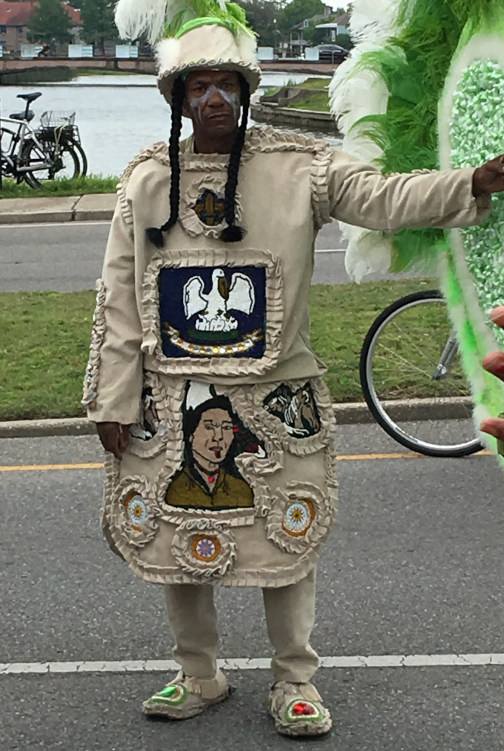
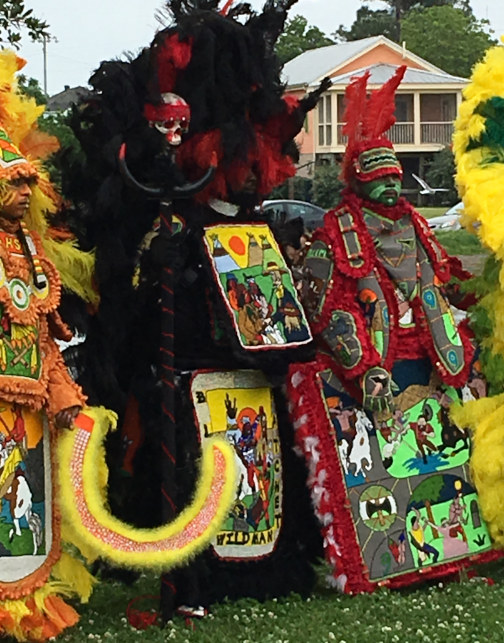
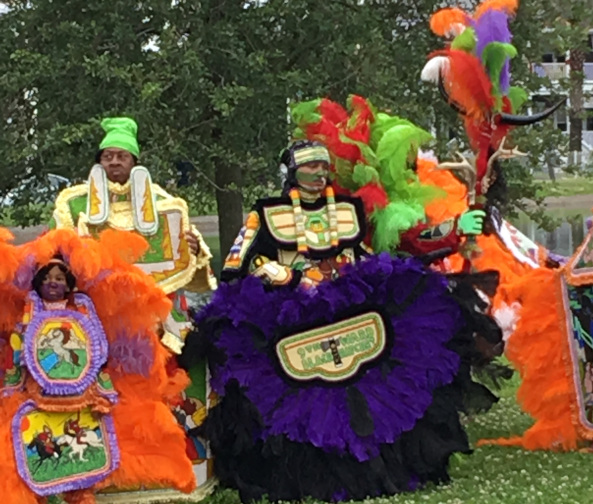
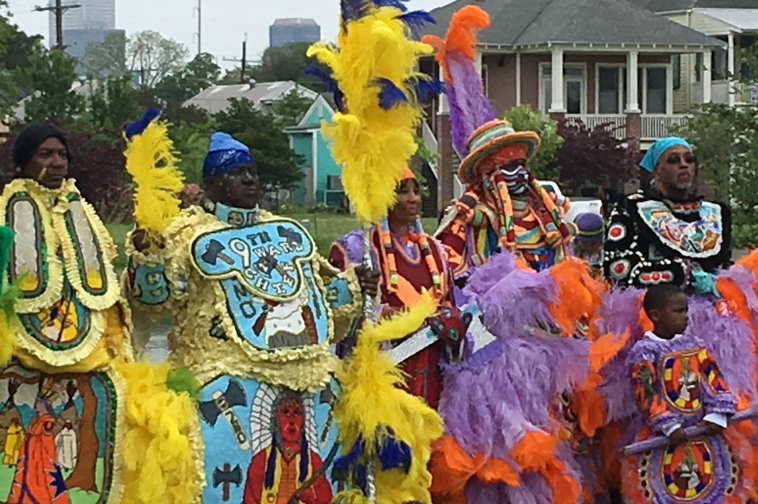
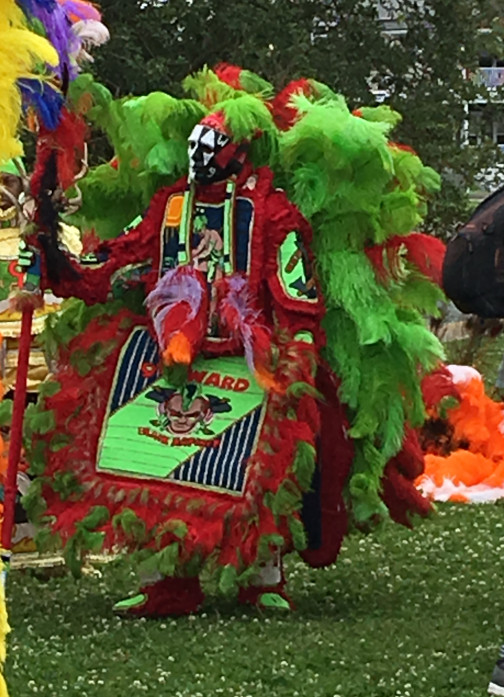
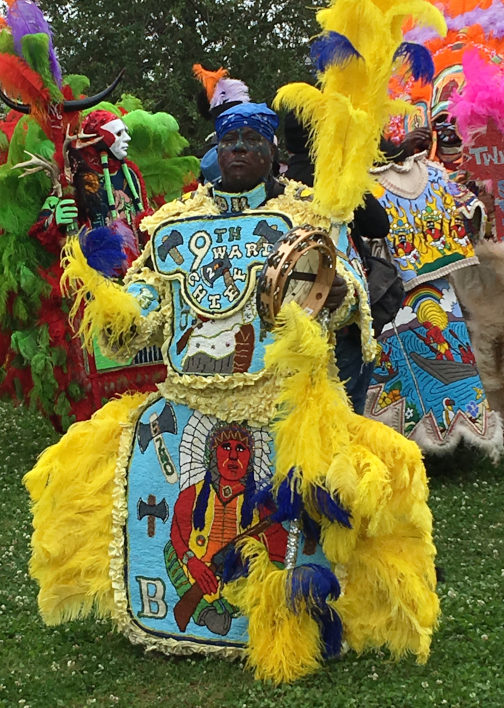
For more pictures of Indians, click here